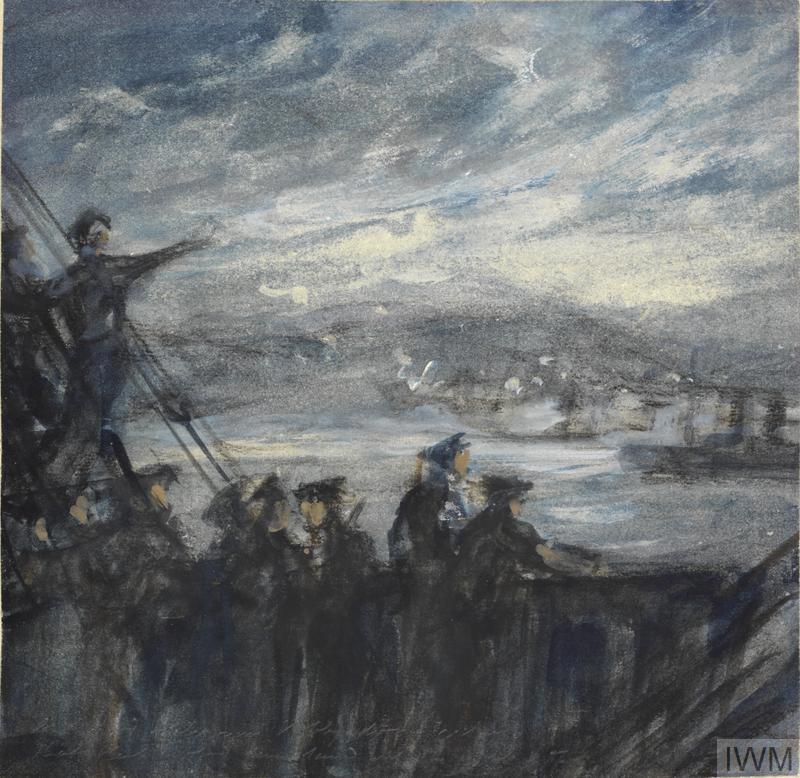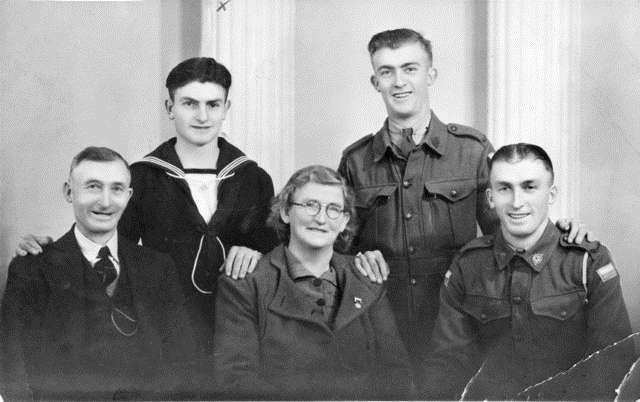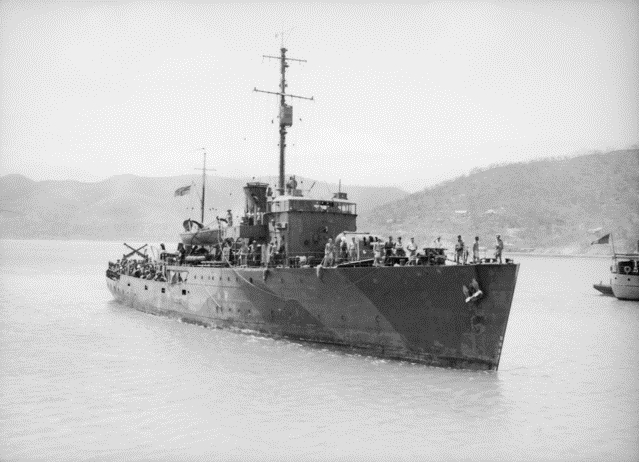19 April 2023
We tell their stories: ANZAC casualties
25th April is ANZAC Day. Here, we tell the stories of some of the brave casualties from Australia and New Zealand that it’s our mission at the Foundation to remember.
We tell their stories
ANZAC troops in the World Wars

The Battle of the Landings - ANZAC - Night, April 25th 1915, Herbet Hillier (© IWM Art.IWM ART 4279)
ANZAC stands for Australian and New Zealand Army Corps.
The first iteration of the ANZAC unit came in World War One. It was an army corps composed of personnel from Australia and New Zealand.
The ANZACs were a varied bunch. It didn’t just include those of European extraction. The units drawn from New Zealand also include Aboriginal, Māori, Torres Strait and Pacific Island servicemen and women.
These soldiers fought in some of the most important theatres of both World War One and Two.
From Italy to Thailand, North Africa to the Middle East, the Western Front to the Pacific, ANZAC troops served with distinction across the world.
 Image: An ANZAC poster from World War One. Over a million ANZAC service personnel served in the World Wars (Wikimedia Commons)
Image: An ANZAC poster from World War One. Over a million ANZAC service personnel served in the World Wars (Wikimedia Commons)
Their most famous action came at Gallipoli, Turkey, in an ill-fated amphibious assault. It was the first time Australia and New Zealand fought as independent nations, taking tens of thousands of casualties in one of the most infamous episodes of World War One.
Around 416,000 Australian troops enlisted in World War One. That was around 39% of the nation’s male population aged 18-44. A further 222,000 New Zealanders, Māori, and Pacific Islanders served in the Great War.
Over 140,00 New Zealanders served in the Armed Forces in World War Two.
Australia significantly stepped up its recruitment drive for World War Two. One million men and women enlisted, with 730,000 alone serving in the Australian Army. That was 10% of the nation’s population at the time.
Commonwealth War Graves commemorate approximately 133,000 ANZAC casualties from the World Wars.
Just over 100,000 are Australian casualties from the army, Australian Merchant Navy, Royal Australian Air Force, and the Royal Australian Navy.
Around 30,000 New Zealand and other ANZAC troops are commemorated in Commonwealth War Graves cemeteries or on memorials in the UK and around the world.
Stories of ANZAC World War casualties
Second Lieutenant Moana-Nui-a-Kiwa Ngarimu VC
 Image: Second Lieutenant Moana-Nui-A-Kiwa Ngarimu (Wikimedia Commons)
Image: Second Lieutenant Moana-Nui-A-Kiwa Ngarimu (Wikimedia Commons)
Moana-Nui-a-Kiwa Ngarimu was born in Whareponga on the East Coast of New Zealand on 7 April 1918.
He was one of 10 children in a prominent Māori family. His aunt, Materoa Reedy, was a prominent tribal leader and advocate of Māori rights.
Moana was a keen sportsman and excelled at rugby during his school days. Following his completion of college, Moana worked as a shepherd on his father’s sheep farm.
On the outbreak of World War Two, Moana joined the 2nd New Zealand Expeditionary Force in February 1940.
He quickly volunteered for the 28th (Māori) Battalion, a Māori-only unit that went on to be New Zealand’s most decorated formation of the war.
With his Battalion, Moana was due to sail for the Middle East but they were diverted to England, arriving in May 1940. A period of intense training followed before the Māori were sent to Egypt in March 1941.
The 28th Battalion then fought in Greece and Crete before being transferred to North Africa. While in the desert, Moana was commissioned as a Second Lieutenant and given command of his own platoon.

Men of the 28th (Māori) Battalion showcasing the iconic Haka in North Africa (Wikimedia Commons)
March 1943. The war in North Africa had shifted to Tunisia following the victory at El Alamein in November 1942.
The 2nd Division, of which the 28th (Māori) Battalion was a key part, was tasked with capturing Tebaga Gap. The Gap was overlooked by several hills. These had to be taken to allow safe passage through the mountain pass.
One such hill was Hill 209, held by fearsome German Panzer Grenadiers. Moana’s company was assigned the difficult task of dislodging the Wehrmacht troops atop Hill 209 and holding it.
The fighting was fierce. The Māori had a literal uphill struggle to capture the hilltop. Eventually, Moana and his men were able to drive the Panzer Grenadiers off Hill 209 and braced for counterattacks.
Moana was twice wounded during several night-time counterattacks. He was ultimately killed on the morning of the 27th of March 1943.
For his actions in capturing and defending Hill 209, Moana was awarded Britain’s highest military honour for valour: the Victoria Cross.
Moana’s VC citation reads:
“Darkness found this officer and his depleted platoon lying on the rock face of the forward slope of the hill feature, with the enemy in a similar position on the reverse slope about twenty yards distant.
“Throughout the night the enemy repeatedly launched fierce attacks in an attempt to dislodge 2nd Lieutenant Ngarimu and his men, but each counterattack was beaten off by 2nd Lieutenant Ngarimu's inspired leadership.
“During one of these counterattacks the enemy, using hand grenades, succeeded in piercing a certain part of the line. Without hesitation, this officer rushed to the threatened area and those of the enemy he did not kill he drove back with stones and with his Tommy-gun.
"During another determined counter-attack by the enemy, part of his line broke. Yelling orders and encouragement, he rallied his men and led them in a fierce onslaught back into their old positions.
“All through the night, between attacks, he and his men were heavily harassed by machine-gun and mortar fire, but 2nd Lieutenant Ngarimu watched his line very carefully, cheering his men on and inspiring them with his personal conduct.
“Morning found him still in possession of the hill feature but only he and two unwounded other ranks remained. Reinforcements were sent up to him. In the morning the enemy again counter-attacked and it was during this attack that 2nd Lieutenant Ngarimu was killed.
“He was killed on his feet defiantly facing the enemy with his Tommy gun at his hip.
“As he fell he came to rest almost on top of those of the enemy who had fallen, the number of whom survived testified to his outstanding courage and fortitude.”
Second Lieutenant Moana-Nui-a-Kiwa Ngarimu is today buried alongside his comrades in Sfax War Cemetery, Tunisia.
Ordinary Seaman Edward Sheean
 Image: Ordinary Seaman Edward Sheean (Wikimedia Commons)
Image: Ordinary Seaman Edward Sheean (Wikimedia Commons)
The Royal Australian Navy (RAN) had a strong presence in the Pacific Ocean and waters in and around Asia during World War Two.
It was the Navy’s job to patrol the seas around Australia to protect them from Japanese incursion.
Threat of a Japanese invasion was a very real possibility for Australia.
In 1942, Imperial Japanese Forces launched a series of lightning strikes, capturing the British colonies of Singapore and Hong Kong and the US-controlled Philippines.
As a response to these shocking events, millions of men and women volunteered to serve in the armed forces. For 18-year-old Edward “Teddy” Sheean, his choice was the Royal Australian Navy.
Teddy was a native of the small town of Latrobe on the island of Tasmania. He was the youngest of 14 children. Five of his brothers had already joined up: four serving with the Australian Army and another with the Royal Australian Navy.

Three of the Sheean brothers with their parents. Teddy can be seen second from the left in his sailor's uniform (Wikimedia Commons)
On the 21st of April, 1942, Teddy joined the Royal Australian Naval Reserve. He trained and served aboard various ships before finally being assigned to the Bathurst-class Corvette HMAS Armidale in August 1942 as an anti-aircraft gunner.
By the time he had come to serve aboard Armidale, the Japanese Navy had stepped up its operations. Japanese midget submarines had even shelled Sydney Harbour, causing a national panic.
The Japanese Army was also making headway on islands and locations near Australia. They had forced a withdrawal of Australian forces on Timor, requiring the RAN to evacuate the stranded Aussie soldiers.
Armidale was part of a three-ship convoy aimed at landing Dutch commandos on Timor while evacuating Dutch and Australian troops.
On the morning of November 30th 1942, Armidale and her sister ships Castlemaine and Kuru were spotted around 100 miles off the coast of Timor by a single Japanese fighter. The plane dropped bombs on the convoy, but missed, turning and heading for the island.
Despite fears that the Japanese plane would give away their location, the boats pushed onwards. They were able to pick up their passengers and return to sea but it would the Armidale’s last journey.
Castlemaine returned to Darwin, Australia while Kuru and Armidale were ordered to return to Timor to pick up more men. The two returning ships headed back to the island, each taking separate routes.
At around 13.00, the skies above Armidale darkened with a flight of Japanese bombers. On their first run, the Japanese planes missed but roughly an hour later Armidale reported she was under attack from “nine bombers and four fighters” while isolated in the Timor Sea.
Armidale immediately took evasive action. Despite her manoeuvres and spitting out a hail of anti-aircraft fire, Armidale was struck at 15:15 by two air-launched torpedoes. One hit her port side while the other collided with Armidale’s engineering spaces. A further bomb exploded aft.

HMAS Armidale before she was sunk by Japanese warplanes (Wikimedia Commons)
At this stage, Armidale had begun to list badly to port. The order was given to abandon ship.
While his crewmates were making for the escape craft, Japanese gunfire strafed the vulnerable seamen.
Teddy was helping to free a life raft and get his comrades out to sea when he was struck by two bullets.
Despite sustaining wounds in his neck and back, Teddy was able to crawl back onto the deck and strap himself onto his Oerlikon 20mm cannon. He began pouring a torrent of fire into the skies.
With Teddy’s gun spitting bullets and tracer fire into the air, the Japanese fighters backed off, unable to strafe the Australian crewmen in the water.
Armidale was sinking rapidly.
Even so, Teddy continued to fire, damaging two aircraft.
Armidale’s stern was soon engulfed by sea waters, but Teddy kept on firing. Even as the waters began to lap around his feet, and sink further and further beneath the waves, Tommy kept up his rate of fire.
One of the survivors, Ordinary Seaman Russel Caro, described the scene:
“During the attack, a plane had been brought down and for this the credit went to Ordinary Seaman Teddy Sheean. Teddy died, but none of us who survived, I am sure, will ever forget his gallant deed ...
“When the order 'Abandon ship' was given, he made for the side, only to be hit twice by the bullets of an attacking Zero. None of us will ever know what made him do it, but he went back to his gun, strapped himself in, and brought down a Jap plane, still firing as he disappeared beneath the waves.”
Many of the survivors of the Armidale sinking attribute their survival to Teddy’s peerless bravery and devotion to duty.
As he has no known grave but the sea, Teddy Sheean is commemorated on the Plymouth Naval Memorial.
While he was mentioned in despatches at the time of Armidale’s sinking, Teddy did not receive any higher honours.
In 2001, the Australian Senate passed a bill to create three Victoria Crosses for Australia. One was rightly given to Teddy Sheean.
Major Rainsford Balcombe-Brown
 Image: Major Rainsford Balcombe-Brown (Auckland War Memorial)
Image: Major Rainsford Balcombe-Brown (Auckland War Memorial)
Aerial combat as always been a deadly pursuit but in the earliest days of military aviation the dangers were even more extensive.
By our standards, aircraft were comparatively crude. Hard to handle, lightly armoured, and relatively slow, military planes were choice targets from the ground and in the air.
Flying in the earliest days of the Royal Air Force took incredible courage. Those who excelled became the famed fighter aces: pilots with 5 or more confirmed victories.
Not every pilot became an ace but their bravery and skill are highly commendable. One such pilot was Wellington-born Rainsford Balcombe-Brown.
Rainsford had been studying at Baliol College, Oxford, alongside his older brother William when the Great War broke out in 1914.
The Balcombe-Browns were quick to enlist, with Rainsford being commissioned into the Royal Field Artillery as a Second Lieutenant.
Rainsford was despatched to France in October 1914 with his regiment but his destiny laid not on the ground but in the sky.
He was soon attached to the Royal Flying Corps (RFC), the precursor to the Royal Air Force, and was quickly piloting his own craft.
Describing his first Rainsford said: “I was so engrossed in looking all around… and enjoying to the full a new sensation.”
After completing his training, Rainford was given his full pilot’s wings and certificates in May 1915.
 Image: The emblem of 56 Squadron, RAF. Rainsford would eventually become commander of the squadron (Wikimedia Commons)
Image: The emblem of 56 Squadron, RAF. Rainsford would eventually become commander of the squadron (Wikimedia Commons)
As a fully-fledged RFC pilot, Rainsford took on reconnaissance flights, bombing attacks and dog fighting against enemy pilots.
Rainsford, now a Lieutenant, was tasked with carrying out balloon-busting and bombing sorties ahead of the 1916 Somme Offensive. He managed to shoot down an enemy observation balloon – no easy task as these were heavily guarded by enemy aircraft – while piloting an unfamiliar aircraft.
For busting this balloon, Rainsford earned the Military Cross.
Rainsford continued to climb the ranks and gain skill as a pilot and leader of men.
By 1918, the Kiwi flyer had reached the rank of Major within the RFC, commanding 56 Squadron.
On 2nd May, 56 Squadron were sent on a special mission to observe and reconnoitre the German frontlines in France.
As Rainsford and his men were flying above enemy lines, a flight of enemy aircraft spotted the RFC planes.
56 Squadron managed to come out on top on the dogfight and drive off their German opponents, but their commander was missing. Rainsford never returned to base.
Originally, Rainsford was reported as missing once 56 Squadron returned to base. A German aviator later dropped a note over British positions stating Rainsford had been killed but gave no further details.
Rainsford Balcombe-Brown was the highest-ranking New Zealand airman killed during World War One. He is buried in Carnoy Military Cemetery in the Somme region of Northern France.
Help us tell the stories of the Commonwealth’s war dead
Keeping the memories of our war dead alive and spreading our shared history is at the core of what we do at the Commonwealth War Graves Foundation.
If you would like to support our work, please consider making a donation.
Why not become a CWGF member? For just £36 a year, you can help us tell their stories while enjoying some big benefits.
Thank you from everyone here at the Commonwealth War Graves Foundation.

